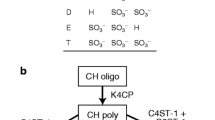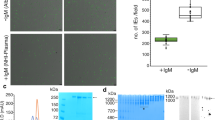Abstract
Adhesion of Plasmodium falciparum infected erythrocytes (IE) to placental chondroitin-4-sulfate (CSA) has been linked to the severe disease outcome of pregnancy-associated malaria. Consequently, sulfated polysaccharides with inhibitory capacity may be considered for therapeutic strategies as anti-adhesive drugs. During in vitro screening a regioselectively modified cellulose sulfate (CS10) was selected as prime candidate for further investigations because it was able to inhibit adhesion to CSA expressed on CHO cells and placental tissue, to de-adhere already bound infected erythrocytes, and to bind to infected erythrocytes. Similar to the undersulfated placental CSA preferred by placental-binding infected erythrocytes, CS10 is characterized by a clustered sulfate pattern along the polymer chain. In further evaluation of its effects on P. falciparum interactions with host erythrocytes, we now show that CS10 inhibits the in vitro asexual growth of parasites in erythrocytes. Furthermore, we show that CS10 interferes with C1 of the classical complement pathway but not with MBL of the lectin pathway. In order to gain insights into the possible interactions of CS10 with known parasite receptors at the molecular level, we designed 3D-structures of characteristic stretches of CS10. CS10 fragments with clustered sulfate groups showed complex patterns of hydrophobic and hydrophilic patches most likely suitable for interactions with protein binding partners. The significance of CS10 interactions with the complement system as well as its anti-malarial effect for prospective drug application are discussed.




Similar content being viewed by others
Abbreviations
- CSA:
-
chondroitin sulfate
- CS10:
-
cellulose sulfate 10 (as described)
- IE:
-
infected erythrocytes
- MBL:
-
mannan binding lectin
- PAM:
-
pregnancy associated malaria
References
Berendt, A.R., Ferguson, D.J., Gardner, J., Turner, G., Rowe, A., McCormick, C., Roberts, D., Craig, A., Pinches, R., Elford, B.C.: Molecular mechanisms of sequestration in malaria. Parasitology 108(Suppl), S19–S28 (1997)
Yamada, M., Steketee, R., Abramowsky, C., Kida, M., Wirima, J., Heymann, D., Rabbege, J., Breman, J., Aikawa, M.: Plasmodium falciparum associated placental pathology: a light and electron microscopic and immunohistologic study. Am. J. Trop. Med. Hyg. 41, 161–168 (1989)
Miller, L.H., Smith, J.D.: Motherhood and malaria. Nat. Med. 4, 1244–1245 (1998)
Rowe, A., Obeiro, J., Newbold, C.I., Marsh, K.: Plasmodium falciparum rosetting is associated with malaria severity in Kenya. Infect. Immun. 63, 2323–2326 (1995)
Sherman, I.W., Eda, S., Winograd, E.: Cytoadherence and sequestration in Plasmodium falciparum: defining the ties that bind. Microbes Infect. 5, 897–909 (2003)
Smith, J.D., Deitsch, K.W.: Pregnancy-associated malaria and the prospects for syndrome-specific antimalaria vaccines. J. Exp. Med. 200, 1093–1097 (2004)
Brabin, B.J.: An analysis of malaria in pregnancy in Africa. Bull. World Health Organ. 61, 1005–1016 (1983)
Fried, M., Nosten, F., Brockman, A., Brabin, B.J., Duffy, P.E.: Maternal antibodies block malaria. Nature 395, 851–852 (1998)
Achur, R.N., Valiyaveettil, M., Alkhalil, A., Ockenhouse, C.F., Gowda, D.C.:Characterization of proteoglycans of human placenta and identification of unique chondroitin sulfate proteoglycans of the intervillous spaces that mediate the adherence of Plasmodium falciparum-infected erythrocytes to the placenta. J. Biol. Chem. 275, 40344–40356 (2000)
Beeson, J.G., Rogerson, S.J., Cooke, B.M., Reeder, J.C., Chai, W., Lawson, A.M., Molyneux, E., Brown, G.V.: Adhesion of Plasmodium falciparum-infected erythrocytes to hyaluronic acid in placental malaria. Nat. Med. 6, 86–90 (2000)
Achur, R.N., Valiyaveettil, M., Gowda, D.C.: The low sulfated chondroitin sulfate proteoglycans of human placenta have sulfate group-clustered domains that can efficiently bind Plasmodium falciparum-infected erythrocytes. J. Biol. Chem. 278, 11705–11713 (2003)
Alkhalil, A., Achur, R.N., Valiyaveettil, C.F., Ockenhouse, C.F., Gowda, D.C.: Structural requirements for the adherence of Plasmodium falciparum-infected erythrocytes to chondroitin sulfate proteoglycans of human placenta. J. Biol. Chem. 275, 40357–40364 (2000)
Clark, D.L., Su, S., Davidson, E.A.: Saccharide anions as inhibitors of the malaria parasite. Glycoconj. J. 14, 473–479 (1997)
Xiao, L., Yang, P.S., Patterson, V., Udhayakumar, V., Lal, A.A.: Sulfated polyanions inhibit invasion of erythrocytes by plasmodial merozoites and cytoadherence of endothelial cells to parasitized erythrocytes. Infect. Immun. 64, 1373–1378 (1996)
Rowe, A., Berendt, A.R., Marsh, K., Newbold, C.I.: Plasmodium falciparum: a family of sulphated glycoconjugates disrupts erythrocyte rosettes. Exp. Parasitol. 79, 506–516 (1994)
Carlson, J., Ekre, H.P., Helmby, H., Gysin, J., Greenwood, B.M., Wahlgren, M.: Disruption of Plasmodium falciparum erythrocyte rosettes by standard heparin and heparin devoid of anticoagulant activity. Am. J. Trop. Med. Hyg. 46, 595–602 (1992)
Andrew, K., Klatt, N., Adams, Y., Mischnick, P., Schwartz-Albiez, R.: Inhibition of chondroitin-4-sulfate-specific adhesion of plasmodium falciparum infected erythrocytes by polysaccharides. Infect. Immun., (in press) (2005)
Newbold, C., Warn, P., Black, G., Berendt, A., Craig, A., Snow, B., Msobo, M., Peshu, N., Marsh, K.: Receptor-specific adhesion and clinical disease in Plasmodium falciparum. Am. J. Trop. Med. Hyg. 57, 289–298 (1997)
Stoute, J.A.: Complement-regulatory proteins in severe malaria: too little or too much of a good thing? Trends in Parasitology 21, 218–223 (2005)
Kirschfink, M., Blase, L., Engelmann, S., Schwartz-Albiez, R.: Secreted chondroitin sulfate proteoglycan of human B cell lines binds to the complement protein C1q and inhibits complex formation of C1. J. Immunol. 158, 1324–1331 (1997)
Kirschfink, M.: Targeting complement in therapy. Immunol. Rev. 18, 177–189 (2001)
Wagenknecht, W., Nehls, I., Philipp, B.: Studies on the regioselectivity of cellulose sulfation in an N2O4-N,N-dimethylformamide-cellulose system. Carbohydr. Res. 240, 245–252 (1993)
Philipp, B., Klemm, D., Wagenknecht, W.: Regioselektive Veresterung und Veretherung von Cellulose und Cellulosederivaten. Teil2. Synthese regioselektiv substituierter Cellulosereste. Das Papier 49, 58–64 (1995)
Philipp, B., Klemm, D., Stein, A.: Regioselektive Veresterung und Veretherung von Cellulose und Cellosederivaten. Teil3. Synthese regioselekiv substituierter Celluloseether und zusammenfassenende Diskussion. Das Papier 49, 102–108 (1995)
Gohdes, M., Mischnick, P., Wagenknecht, W.: Methylation analysis of cellulose sulphates. Carbohydr. Polym. 33, 163–168 (1997)
Gohdes, M., Mischnick, P.: Determination of the substitution pattern in the polymer chain of cellulose sulfates. Carbohydr. Res. 309, 109–115 (1998)
Trager, W., Jensen, J.B.: Human malaria parasites in continuous culture. Science 193, 673–675 (1976)
Lambros, C., Vandenberg, J.P.: Synchronisation of Plasmodium falciparum stages in culture. J. Parasitol. 65, 418–420 (1979)
Jensen, J.B.: Concentration from continuous culture of erythrocytes infected with trophozoites and schizonts of Plasmodium falciparum. Am. J. Trop. Med. Hyg. 27, 1274–1276 (1978)
Walliker, D., Quakyi, I.A., Wellems, T.E., McCutchan, T.F., Szarfman, A., London, W.T., Corcoran, L.M., Burkot, T.R., Carter, R.: Genetic analysis of the human malaria parasite Plasmodium falciparum. Science 236, 1661–1666 (1987)
Wellems, T.E., Oduola, A.M.J., Fenton, B., Desjardins, R., Panton, L.J., do Rosario, V.E.: Chromosome size variation occurs in cloned Plasmodium falciparum on in vitro cultivation. Rev. Bras. Genet. 11, 813–825 (1988)
Andrews, K.T., Walduck, A., Kelso, M.J., Fairlie, D.P., Saul, A., Parsons, P.G.: Anti-malarial effect of histone deacetylation inhibitors and mammalian tumour cytodifferentiating agents. Int. J. Parasitol. 30, 71–768 (2000)
Leitao, M.F., Vilela, M.M.S., Rutz, R., Grumach, A.S., Condino-Neto, A., Kirschfink, M.: Complement factor I deficiency in a family with recurrent infections. Immunopharmacology 38, 207–213 (1997)
Bohne, A., Lang, E., von der Lieth, C.W.: SWEET-WWW-based rapid 3D construction of oligo- and polysaccharides. Bioinformatics 15, 767–768 (1999)
Lutteke, T., Frank, M., von der Lieth, C.W.: Carboyhdrate Structure Suite (CSS): analysis of carbohydrate 3D structures derived from the PDB. Nucleic Acids Res. 33(database issue), D242–D246 (2005)
Pouvelle, B., Buffet, P.A., Lepolard, C., Scherf, A., Gysin, J.: Cytoadhesion of Plasmodium falciparum ring-stage-infected erythrocytes. Nat. Med. 6, 1264–1268 (2000)
Aikawa, M., Iseki, M., Barnwell, J.W., Taylor, D., Oo, M.M., Howard, R.J.: The pathology of human cerebral malaria. Am. J. Trop. Med. Hyg. 43, 30–37 (1990)
Gamain, B., Gratepanche, S., Miller, L.H., Baruch, D.I.: Molecular basis for the dichotomy in Plasmodium falciparum adhesion to CD36 and chondroitin sulfate A. Proc. Natl. Acad. Sci. USA. 99, 10020–10024 (2002)
Rogerson, S.J., Tembenu, R., Dobano, C., Plitt, S., Taylor, T.E., Molyneux, M.E.: Cytoadherence characteristics of Plasmodium falciparum-infected erythrocytes from Malawian children with severe and uncomplicated malaria. Am. J. Trop. Med. Hyg. 61, 467–472 (1999)
Aitman, T.J., Cooper, L.D., Norsworthy, P.J., Wahid, F.N., Gray, J.K., Curtis, B.R., McKeigue, P.M., Kwiatkowski, D., Greenwood, B.M., Snow, R.W., Hill, A.V., Scott, J.: Malaria susceptibility and CD36 mutation. Nature 405, 1015–1016 (2000)
Serghides, L., Kain, K.C.: Peroxisome proliferator-activated receptor gamma-retinoid X receptor agonists CD36-dependent phagocytosis of Plasmodium falciparum-parasitized erythrocytes and decrease malaria-induced TNF-alpha secretion by monocytes/macrophages. J. Immunol. 166, 6742–6748 (2001)
Nathoo, S., Serghides, L., Kain, K.C.: Effect of HIV-1 antiretroviral drugs on cytoadherence and phagocytic clearance of Plasmodium falciparum-parasitized erythrocytes. Lancet 362, 1039–1041 (2003)
Cerami, C.U., Frevert, U., Sinnis, P., Takacs, B., Clavijo, P., Santos, M.J., Nussenzweig, V.: The basolateral domain of the hepatocyte plasma membrane bears receptors for the circumsporozoite protein of plasmodium falciparum sporozoites. Cell 70, 1021–1033 (1992)
Beeson, J.G., Chai, W., Rogerson, S.J., Lawson, A.M., Brown, G.V.: Inhibition of binding of malaria-infected erythrocytes by a tetradecasaccharide fraction from chondroitin sulfate A. Infect. Immun. 66, 3397–3402 (1998)
Butcher, G.A., Parish, C.R., Cowden, W.B.: Inhibition of in vitro growth of Plasmodium falciparum by complex polysaccharides. Trans. R. Soc. Trop. Med. Hyg. 82, 558–559 (1988)
Cockburn, I.A., Mackinnon, M.J., O’Donnell, A., Allen, S.J., Moulds, J.M., Baisor, M., Bockarie, M., Reeder, J.C., Rowe, J.A.: A human complement receptor 1 polymorphism that reduces Plasmodium falciparum rosetting confers protection against severe malaria. Proc. Natl. Acad. Sci. USA. 101, 272–277 (2004)
Wenisch, C., Spitzauer, S., Florris-Linau, K., Rumpold, H., Vannaphan, S., Parschalk, B., Graninger, W., Looareesuwan, S.: Complement activation in severe Plasmodium falciparum malaria. Clin. Immunol. Immunopathol. 85, 166–171 (1997)
Craig, M.L., Waitumbi, J.N., Taylor, R.P.: Processing of C3b-opsonized immune complexes bound to non-complement receptor 1 (CR1) sites on red cells: phagocytosis, transfer, and associations with CR1. J. Immunol. 174, 3059–3066 (2005)
Acknowledgment
This work was supported by a grant from the Deutsche Forschungsgemeinschaft (DFG) SFB 544 “Control of Tropical Infectious Diseases.”
Author information
Authors and Affiliations
Corresponding author
Rights and permissions
About this article
Cite this article
Schwartz-Albiez, R., Adams, Y., von der Lieth, CW. et al. Regioselectively modified sulfated cellulose as prospective drug for treatment of malaria tropica. Glycoconj J 24, 57–65 (2007). https://doi.org/10.1007/s10719-006-9012-1
Published:
Issue Date:
DOI: https://doi.org/10.1007/s10719-006-9012-1




